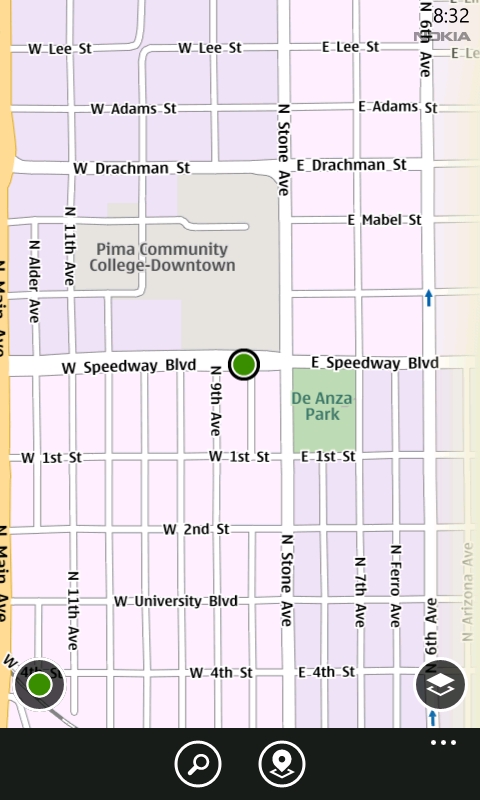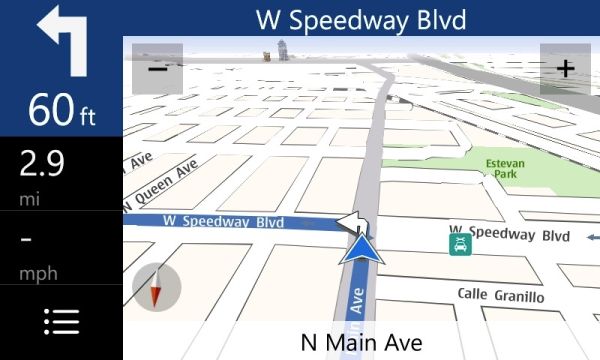Nokia Lumia 800 Review - Nokia's Brave New Foray into WP7
by Brian Klug on January 4, 2012 7:00 AM EST- Posted in
- Smartphones
- Nokia
- windows phone 7
- Mobile
- WP7
- Lumia
- Lumia 800
Of chief interest in the context of the Lumia 800 review are the software preloads that come on our device. This is again something that can change between regions and carriers. Our Lumia 800 came preloaded with a number of Nokia apps that have been ported from other platforms - Nokia Music, Nokia Drive, Nokia Maps, and Application Highlights. In addition the Lumia 800 comes by default with a Nokia Blue color theme, an interesting and nice little touch.
Nokia’s Apps
Nokia Drive provides turn-by-turn navigation, and on first launch downloads voice guidance and maps based on your choice of locale. It isn’t freely available in the market, but does get marketplace updates and, in the course of the review, has received more than a few. I drove around with Nokia Drive a few times and found that its turn-by-turn guidance does work well, though there’s no way to leave the application running and reply to a text message, for example. You’re either getting guidance and inside the application or getting no guidance at all if answering a call or replying to an SMS (not that you'd do that while driving, right?). Going back into navigation also takes a few seconds while the GPS comes back up, something else to keep in mind. I’m not sure whether the difficulty here is providing functionality that can’t be achieved with the current state of WP7 background APIs, but it’s a noteworthy omission.
The UI also feels a bit off for WP7, something I’ve seen other people note as well. In fact, the Nokia Drive interface seems to be an almost 1:1 port from the N9. For a port, the software admittedly does work well and seems speedy enough, but does depart from the Metro style guidelines with its menus and navigation. If you can get over that small negative, Nokia Drive does indeed provide a very competent turn-by-turn voice navigation experience that gets the job done very well. Oh, and best of all it’s pre-installed on the whole Nokia Lumia range.

Nokia Maps
Nokia Maps is next, which again is a close analog of Nokia Maps from the N9. This has more of a Metro UI feel to it, and on the Lumia 800, is no doubt positioned to take the place of Microsoft’s first party Bing Maps solution. It’s a 2D perspective top-down view with Nokia fonts and themeing that we’ve seen many times before on Nokia phones. As expected, it delivers with three different map view options - map, satellite, and public transport - whose views are self explanatory. The Nokia Maps application also feels much more at home inside Metro-ized WP7 than Nokia Drive.
Nokia Music is something of an analog to Zune Music and Videos, and by default lets you browse your existing music collection under “my music” and view local music events under “gigs.” With a Nokia account, you can also apparently stream and mix music, though I don’t have a Nokia Music account provisioned for such things.
App highlights is another Nokia specific application and provides a nicely curated list of applications that everyone should install on virtually any WP7 device out of the box. YouTube, Netflix, Yelp, Facebook, Adobe Reader and those sort of must-have applications are all listed with marketplace links. It is telling about the functionality still missing from the core of WP7 that you need to go download a YouTube and Adobe Reader application from the market to use those things, but Nokia has done a nice job listing all of it. Of course there are also some app recommendations for a few other categories of applications as well, all of which link to the main marketplace.
This pretty much wraps up all the Nokia-specific applications. The rest of the Nokia-specific customizations include small things like the two Nokia feedback entry points, and the interesting little theme customization I mentioned earlier. At this point, it’s definitely obvious that Nokia’s presence is in its few software sideloads, but going forward with WP7 it’s also apparent that their influence will take on a much larger role.
Mango Explored
We haven’t had an opportunity to take a larger look at WP7.5 “Mango” until now, and it bears going over the numerous improvements that have been made to the platform since last we visited it. Microsoft unsurprisingly has a nice rundown with the changes but we should still go over the larger ones.
.jpg)
.jpg)
The new IE browser (left), Mango's multitasking interface (right)
I still think the largest change of all is the much-needed IE update, but the other major thing is introduction of a multitasking interface. WP7 already had multitasking features, but navigation purely with the back button could admittedly be confusing in a world where both Android and WP7 use this “back” paradigm so heavily. Now, holding down back brings up a nice switcher that lets you page back and forth between activities. It doesn’t switch in-between apps per-se, but rather the topmost screen in an activity stack - eg, you can go into one and tap back until you wind up back at the home screen. The list isn’t infinite either and reflects whether the OS has expunged an application. It’s almost like webOS’ card switcher, but a bit different. Background agents are now present, which is close to true multitasking, yet you can still sense that things close. The interface presents an easy way to switch between views, but it can still be confusing to switch between given applications.
.jpg)
.jpg)
Mango also brings a bunch of communication-related improvements. Messaging now includes MSN Messenger and Facebook chat functionality, and speech-to-text dictation. The email client now includes a conversation view that groups messages by subject appropriately, and inbox linking if you prefer viewing a single inbox. It’s confusing to me that the excellent IM and SMS combined view doesn’t include support for more IM platforms or plugins, hopefully this is coming at some later date.
.jpg)
.jpg)
Microsoft also improved a bunch of their first party applications, including the People hub, which now integrates Twitter and LinkedIn in addition to Facebook, along with better organization and groups. Search now includes camera functionality which can scan text and 2D barcodes (QR codes and Microsoft tags). Again Mango brings a bunch of subtle improvements to Microsoft’s first party applications that are welcome, to say nothing of the new APIs that many people wanted for WP7 (including network sockets, clipboard, background agents, etc.).
The features that have been added in Mango bring the platform up to a point where it arguably should’ve been 6 months before it finally hit, but better late than never for the platform.



_thumb.jpg)
_thumb.jpg)
_thumb.jpg)
_thumb.jpg)
_thumb.jpg)
_thumb.jpg)








120 Comments
View All Comments
AnnihilatorX - Wednesday, January 4, 2012 - link
I like how the debug mode battery status readsCharged
65535%
Binary-decimal system for the geeks :)
deputc26 - Wednesday, January 4, 2012 - link
nexusct760ster - Thursday, January 5, 2012 - link
16-bit depth of charge. That's why I strive for True-charge B-)piroroadkill - Wednesday, January 4, 2012 - link
Honestly, the N9 is nicer, being almost the same but with a cleaner front (no windows buttons) and an interesting OS as opposed to WP7.Still, it's a dead end. But a pretty dead end.
Freddo - Wednesday, January 4, 2012 - link
Yep, I'm very interested in the N9 myself. Still haven't bought it yet though, it's been 5+ years since I had a mobile phone without ScummVM and I'm not going back to that now. So someone need to port ScummVM for it first.inplainview - Wednesday, January 4, 2012 - link
I have an N9 and it is a nice device. I use it as a backup to my iPhone and it is quite worth. A bit quirky but still a nice phone. I like it MUCH better than the Android copy devices floating around.sprockkets - Wednesday, January 4, 2012 - link
Only seen one briefly in person. Would have bought it too instead of android were it not for Nokia abandoning the platform.What a way to treat your community Nokia!
bplewis24 - Wednesday, January 4, 2012 - link
Keep telling yourself that. I hope it helps you sleep better at night or something.zwer - Wednesday, January 4, 2012 - link
ScummVM was ported within two months for its predecessor, the N900, and is officially supported by the ScummVM community. Given the virtually identical (considering the ScummVM requirements) architecture from both the software and hardware point of view between Maemo 5 and Maemo 6 / MeeGo Harmattan, I'm quite sure someone will rebuild it for the N9 as well, quite soon.'til then, when it comes to emulators/VMs, the EmuMaster pretty much covers the rest - NES, SNES, GB(A), PSX and Amiga (UAE).
kishorshack - Wednesday, January 4, 2012 - link
I expect Nokia and Intel partnership to continueBut this Nokia CEO stephen elop ruined everything for Nokia
First He went against what consumers wanted & went with WP7 instead of android
He killed Meego and stopped Meego devices
N9 was overly priced and Made available in very few countries
Every single thing was done
Purposely
Sad :(